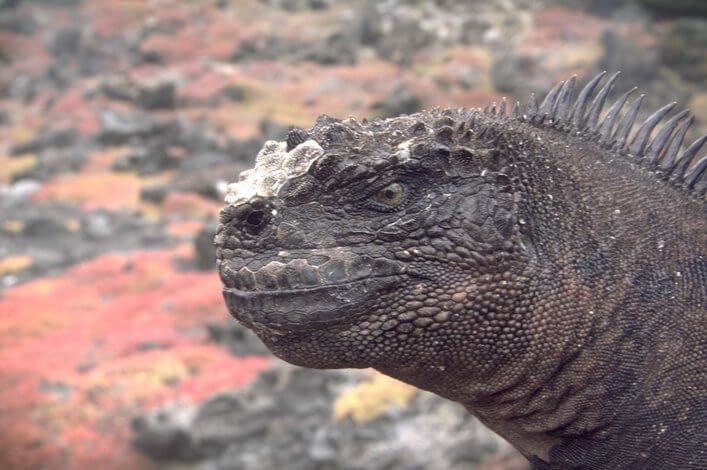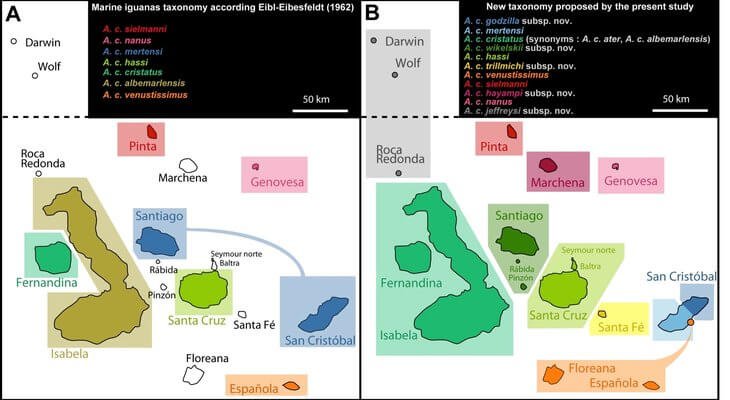
The Galapagos Marine Iguana is one of the key endemic species that is distributed throughout the archipelago. Recently, a team of European and Latin American scientists led by Dr. Sebastian Steinfartz of the Braunschweig Technical University in Germany studied the diversity of the Galapagos marine iguana (Amblyrhynchus cristatus), presenting an interesting update on this species.
The scientists performed genetic and morphological studies, through which 11 subspecies of marine iguanas could be differentiated, of which, five were recently described.
"It was amazing that most of the populations on the different islands had significant differences in morphology and coloring compared to their neighbors on other islands" said Dr. Aurelien Miralles of the Museum of Natural History in Paris, France, who performed most of the analysis.
The five new subspecies are: A. c. hayampi subspec. nov. (Marchena), A. c. jeffreysi subsp. nov. (Wolf and Darwin), A. c. cristatus, A. c. godzilla subsp. nov. (San Cristóbal-Punta Pitt), A. c. trillmichi subsp. nov. (Santa Fé) and A. c. wikelskii subsp. nov. (Santiago); and the six subspecies already known are the following: Amblyrhynchus cristatus cristatus (Isabela and Fernandina), A. c. nanus (Genovesa), A. c. venustissimus (Española), A. c. hassi (Santa Cruz), A. c. mertensi (San Cristóbal) and A. c. sielmanni (Pinta); And totalling 11 subespecies.

The largest subspecies is over one meter in length, is located in the north of San Cristobal Island and was named Godzilla Marine Iguana (Amblyrhynchus cristatus godzilla).
As Sebastian Steinfartz explains: "This subspecies has a particular coloration and impressive stature, which really remembers Godzilla, the fictional saurian monster created in 1954 by T. Tanaka”.
Marine iguanas are a vulnerable species according to International Union for Conservation of Nature (IUCN) criteria, for threats such as predation by feral animals (cats, rats and dogs) and human interaction, mainly in urban centers. However, climate change is another threat for this species, because when the El Niño Phenomenon arrive to the islands, this has a direct effect on these saurians, mainly due to the decrease in food.
The marine iguana is protected by the laws of the Republic of Ecuador. Currently, scientists work to understand their ecology, biology and threats, to inform technical recommendations to the Galapagos National Park Directorate (GNPD), which will allow their long-term conservation.
Reference:
Miralles Aurélien, MacLeod Amy, Rodríguez Ariel, Ibáñez Alejandro, Jiménez-Uzcategui Gustavo, Quezada Galo, Vences Miguel, Steinfartz Sebastián. Shedding light on the Imps of Darkness: An integrative taxonomic revision of the Galapagos marine Iguanas (genus Amblyrhynchus). Zoological Journal of the Linnean Society, 2017, XX, 1–33. DOI: 10.1093/zoolinnean/zlx007
For more information:
Godzilla of the Galápagos and other speciation stories.
Dr Aurélien Miralles, ISYEB, UMR7205 MNHN-CNRS-UPMC-EPHE, Muséum National d’Histoire Naturelle, Département Systématique et Evolution, CP30, 25 rue Cuvier 75005 Paris, France. Email: miralles.skink@gmail.com
Dr Sebastian Steinfartz, Technical University of Braunschweig, Division of Evolutionary Biology, Zoological Institute, Mendelssohnstr. 4, 38106 Braunschweig, Germany. Email: s.steinfartz@tu-bs.de




